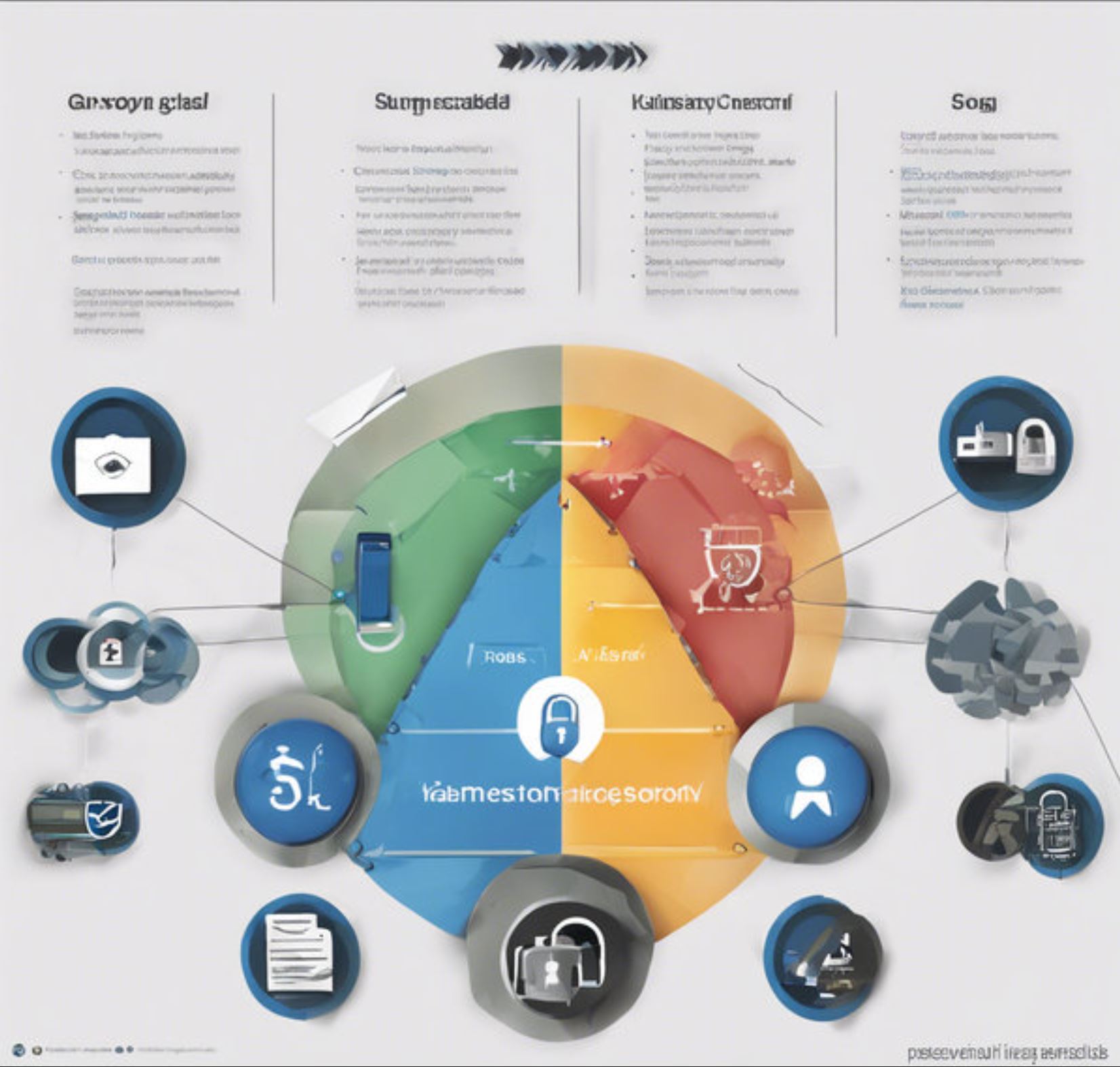CISO Blog
The Hybrid Approach to Information Security Frameworks
Tired of the one-size-fits-all approach to security? It’s time to break free from the mold and build a custom security fortress that’s tailored to your organization’s unique needs.
As a seasoned CISO, I’ve seen the limitations of relying on a single framework. A hybrid approach, combining elements from different frameworks, is the key to unlocking the full potential of your security program.
Here’s what you can achieve with a hybrid approach:
Tailored protection: Align your security posture with your specific risks and goals.
Enhanced flexibility: Adapt to the ever-changing threat landscape with ease.
Leverage best practices: Benefit from a wider range of security controls and strategies.
Address diverse needs: Cover all your bases, from risk management to compliance and incident response.
But remember, a hybrid approach is not a one-and-done solution. It requires careful planning, implementation, and ongoing maintenance.

Forget the One-Size-Fits-All Approach

In the world of information security, trying to cram your organization into a single framework is like trying to fit a square peg into a round hole. It’s just not going to work.
There are regulatory frameworks you just HAVE to comply with, like PCIDSS, GDPR and others, but I am talking more about the general frameworks and here the hybrid approach is the way to go. By combining elements from different frameworks, you can create a security solution that’s tailored to your unique needs and risk profile. It’s like building your own custom security fortress.
There are numerous benefits to following this Hybrid Approach,
- Tailored Protection: By combining different frameworks, you can create a customized security posture that aligns with your specific needs and risk profile.
- Enhanced Flexibility: A hybrid approach allows for greater flexibility in adapting to changing threats and regulatory requirements.
- Leveraging Best Practices: By incorporating elements from multiple frameworks, you can benefit from a wider range of best practices and security controls.
- Addressing Diverse Needs: Different frameworks may excel in specific areas, such as risk management, compliance, or incident response. A hybrid approach can ensure that all critical aspects of information security are adequately addressed.
Like everything in this word, there is the “But wait, there is more!!” or in this case there is a catch:
- Don’t just throw frameworks together. Make sure they align with your business goals and comply with relevant regulations.
- Consider your resources. Implementing a hybrid approach takes time, money, and expertise. So don’t bite off more than you can chew.
- Make it work together. Integrate your frameworks seamlessly so they don’t clash or create gaps in your security.
- Keep it updated. The threat landscape is constantly changing, so your security strategy needs to evolve with it.
And remember, certifications can be a valuable tool. They can demonstrate your commitment to security and provide your team with valuable training. But they’re not a silver bullet.
The bottom line: A hybrid approach is the key to building a strong and effective information security program. By carefully considering your options and tailoring your strategy to your specific needs, you can protect your organization from the dynamic threat environment.
Here are some of the more popular frameworks.
Comprehensive Frameworks
- NIST Cybersecurity Framework (CSF): Developed by the National Institute of Standards and Technology (NIST), this framework provides a voluntary, flexible, and risk-based approach to cybersecurity.
- ISO 27001 and ISO 27002: International standards that establish a comprehensive information security management system (ISMS). ISO 27001 specifies the requirements for an ISMS, while ISO 27002 provides best practices for implementing it.
- CIS Controls: A set of security controls developed by the Center for Internet Security (CIS) that can be used to protect IT systems and data.
Industry-Specific Frameworks
- HIPAA (Health Insurance Portability and Accountability Act): A U.S. federal law that sets standards for the protection of personally identifiable health information (PHI).
- PCI DSS (Payment Card Industry Data Security Standard): A set of security standards that must be followed by any organization that handles credit card data.
- NIST 800-171: A U.S. federal standard that provides a set of security requirements for contractors handling controlled unclassified information (CUI).
- COBIT (Control Objectives for Information and Related Technology): A framework that provides a comprehensive set of control objectives and practices for IT governance and management.
- ITIL (Information Technology Infrastructure Library): A set of best practices for IT service management.
Other Frameworks
- ISO 27017: Provides guidance on information security controls for cloud services.
- ISO 27018: Provides guidance on the protection of personally identifiable information (PII) in the public cloud.
- NIST 800-53: A U.S. federal standard that provides a catalog of security controls that can be used to protect federal information systems.
- NIST 800-172: A U.S. federal standard that provides a set of security requirements for cloud computing.
CISO Blog
Law Firm Fiasco – A GDPR Reality Check

Alright folks, gather ’round as I, the man with the cyberplan, unravel the messy saga of DPP Law—a masterclass in flouting data handling in our cyber-savvy, regulation-driven world. This case is a wake-up call, so grab your popcorn and prepare to learn from someone else’s very expensive lesson.

The U.K.’s Information Commissioner’s Office (ICO) just slammed Liverpool’s DPP Law with a £60,000 fine for a GDPR mishap of epic proportions. Back in 2022, hackers had a field day with DPP’s data, ransacking 32.4 gigabytes of sensitive client details—a treasure trove soon showcased on the darkweb’s version of Broadway.
DPP’s errors read like a cybersecurity 101 failure course: still clinging to an outdated, high-privilege account, oblivious to the possibilities of risk, and, shockingly, neglecting to tell the ICO about the breach for 43 days. Let me remind you, the law’s crystal clear: report within 72 hours or else brace for impact.
Here’s the kicker: our crafty criminals hijacked a device and nosedived into a SQLuser admin account stripped of multifactor authentication. Meanwhile, DPP’s firewall didn’t flicker, that’s when they needed an early’ warning, it serenely waved them through. Even after the blow, DPP clung to their outdated system without question—blissfully unaware till the National Crime Agency gave them the wakeup call no one wants: “Hey mates, your client info’s a hot item on the darkweb.” Embarrassing, right?
Andy Curry from ICO lays it bare: data protection isn’t just a prudent choice—it’s the law. Mess up and you’ll pay dearly in currency and credibility alike. This chilling misadventure screams it clear: you can’t treat client data like some dusty file in the basement.
So, what’s the takeaway? If you’re not making data protection your New Year’s resolution every year, think again. Refresh those outdated systems, patch the vulnerabilities, enable multifactor authentication, and audit like your results hit tomorrow’s headlines!
While DPP Law ponders an appeal, let’s all sit up and listen. If you’re handling sensitive information, keep your act tight. Because in this treacherous terrain of cybercrime, negligence isn’t just irresponsible; it’s costly. Stay sharp, tighten those belts, and remember: among all protections, vigilance never goes out of style.
CISO Blog
Season 2 Episode 5 of The Troublemaker CISO: Black Basta Unmasked – A Chat Log Reveal
Buckle up, folks! The notorious Black Basta ransomware gang just took a major hit as their internal chat logs got spilled online. This isn’t just your average leak—it’s a treasure trove revealing their dark secrets, shady tactics, and the infighting simmering among the ranks. Want to know how they operate, who’s running the show, and how you can fortify your defenses against these digital pirates? Dive into the chaos of Black Basta with us and discover how even the murkiest corners of cybercrime can get shed light on!

Hold onto your hats, folks, because in a twist likely to make even the most seasoned hackers cringe, the infamous Black Basta ransomware gang just got hit with a dose of exposure. In February 2025, their internal chat logs spilled onto the internet, lifting the veil on their clandestine operations and potentially outing some key players behind the digital mayhem.
Who is Black Basta?
If you want the full backstory check out our deep dive into Black Basta, available here
Here is the short version: Emerging in April 2022, Black Basta quickly burst onto the scene as a formidable Ransomware-as-a-Service (RaaS) operation. By targeting sectors ranging from healthcare to entertainment, this gang’s reputation precedes them—over 500 organizations globally can attest to their wrath. Their calling card? The notorious double extortion play: encrypt the system and filch sensitive data, then demand a ransom with the threat of public leaks if unpaid.
Word on the street suggests Black Basta might be the unholy offspring of the now-defunct Conti ransomware and FIN7 threat actor groups. Whether a fusion or a reincarnation, they’re built on a foundation of bad intentions and digital crime prowess.
Digging Into Their Methods
With a toolbox full of advanced techniques, Black Basta crafts their attack strategy like a maestro:
– Starting Point: They breach defenses with spear-phishing, insider help, or buying network access. Recently, they even resorted to misusing Microsoft Teams, impersonating IT help desks to trick employees into opening their networks wide open.
– Onward and Upward: Once inside, they move laterally, scooping up credentials with tools like QakBot and Mimikatz. Vulnerabilities like ZeroLogon and PrintNightmare? They exploit those like kids in a candy store.
– Keeping Tabs: Using Cobalt Strike Beacons and SystemBC, they maintain a firm grip on compromised systems.
– The Double Hit: Before encrypting files and appending their signature “.basta” extension, they disable security measures and exfiltrate data with tools such as Rclone and WinSCP, leaving a ransom note as the cherry on top.
The Chat Log Leak Bombshell
Enter the catalyst for chaos: a character named ExploitWhispers unleashed reams of the gang’s internal chat messages via the Matrix platform, covering conversations from September 2023 to September 2024. The logs unveil more than just tactical playbooks—they expose friction and deceit within Black Basta’s ranks.
PRODAFT, keen-eyed cyber defenders, suggest this leak might stem from discord following alleged attacks on Russian banks—a tale not too dissimilar from the notorious Conti leaks. Leaked messages hint at some operators double-crossing victims by taking ransom without decryptors. Some top dogs ditched for rival groups while the rest grappled with the realization that Black Basta’s punch was getting weaker.
And guess what? Names emerged in the chats:
– Lapa: An admin.
– Cortes: Linked to QakBot.
– YY: The prime administrator.
– Trump (aka GG and AA): Allegedly Oleg Nefedov, the head honcho.
Security researchers are scrutinizing the logs, eager to piece together the digital puzzle, with Hudson Rock even rolling out an LLM to delve deeper.
Ladies and gents, as we peer through this unexpected window into the underworld, remember: even the darkest recesses of the internet can be dragged into the light. Keep eyes peeled, ears to the ground, and let’s keep giving troublemakers like Black Basta a run for their crypto.
CISO Blog
Season 2 Episode 4 of The Troublemaker CISO: Salt Typhoon – An Unrelenting Storm on Telecoms
In the relentless digital battleground of 2025, Salt Typhoon is churning up a storm that telecoms can’t ignore. This state-sponsored cyber squad is at it again, infiltrating networks and dodging detection with their infamous espionage tactics. Targeting telecom giants worldwide, they’re exploiting vulnerabilities faster than you can say “patch it!” How do we defend against this relentless assault? By building robust, multi-layered defenses and staying one step ahead. Ready to weather the storm, troubleshooters? Dive in to uncover the strategies that can fortify our digital fortress against Salt Typhoon’s unyielding deluge.

Ladies and gentlemen, buckle up, because Salt Typhoon is back at it, causing a ruckus in our digital playgrounds. This Chinese state-sponsored APT group is no stranger to controversy, and February 2025 has them splashed across headlines once more. Their playground? Telecommunications and critical infrastructure. Their game? Cyber espionage for world domination, or at least to gather intelligence and strategic advantage.

How It All Began
Salt Typhoon blustered onto the scene around 2020, quickly turning into a high-priority headache for cybersecurity pros everywhere. They cut their teeth by:
- Nabbing holes in public-facing servers like Microsoft Exchange to break in.
- Spying on hotels, governments, and law firms, trying to catch influential figures off guard.
- Crafting sneaky backdoors like SparrowDoor and Demodex to stick around on breached systems.
- Dodging detection with top-notch anti-forensic shenanigans.
Over the years, their style evolved, adding “living off the land” tactics and honing in on juicier targets.
Read the full Threat report on Salt Typhoon
The 2025 Storm Surge
Fast forward to the chaos of 2025, and Salt Typhoon is back under the spotlight:
- Busting into U.S. telecom bones through unpatched Cisco IOS XE devices. Ouch!
- Attacking over 1,000 Cisco network gadgets worldwide, hitting the U.S., South America, and India hard.
- Compromising telecom giants like a U.S. ISP, U.K. affiliate networks, a South African provider, an Italian ISP, and a major player in Thailand.
- Deploying GhostSpider malware to weave their web.
- Exploiting well-trodden vulnerabilities in Cisco gear—CVE-2023-20198 and CVE-2023-20273—to snag admin access.
- Probing universities for their sweet research in telecom, engineering, and tech.
Their focus? Espionage, persistence, and staying ahead of geopolitical showdowns by intercepting data flows whenever it suits them.
The Fallout
Salt Typhoon’s actions ripple far beyond just cybersecurity headaches:
- National security risks: Breaching surveillance systems jeopardizes law enforcement and national operations.
- Data privacy violations: Personal and sensitive info is laid bare, compromising organizations and individuals.
- Threats to critical infrastructure: Telecommunication disruptions can snowball, impacting countless sectors.
Batten Down the Hatches
What’s a savvy guardian of cyberspace to do? Here’s how to withstand the storm:
- Roll out robust security frameworks like zero-trust architectures and keep vigilant with continuous monitoring.
- Patch those vulnerabilities, stat! Quickly seal any discovered holes to keep your defenses tight.
- Boost network visibility and keep an eagle eye on unusual behavior.
- Fortify infrastructure with segmentation, access controls, and souped-up VPN gateways.
- Share the wisdom: Stay in the know about Salt Typhoon’s latest tricky tactics.
- Bolster those Cisco devices.
Taking a hands-on, multi-layered approach is the only way to stay ahead of Salt Typhoon and other nefarious state-sponsored groupies. Let’s keep the umbrella of preparedness over our heads in the fast-moving digital storm. Stay sharp, troubleshooters—the world depends on it!
-

 Organizational Transformation5 months ago
Organizational Transformation5 months agoDigital Transformation: Shaping the Future of Modern Enterprises
-

 CISO Blog4 months ago
CISO Blog4 months agoSalt Typhoon, an advanced persistent threat
-

 Threat Actors6 months ago
Threat Actors6 months agoThe Russian Bear Unleashed: The Cyber Threat of APT28
-

 CISO Blog7 months ago
CISO Blog7 months agoNIST Drops Password Complexity and Mandatory Reset Rules: A New Era for Password Security
-

 CISO Blog3 months ago
CISO Blog3 months agoIt’s Time to Close the Software Understanding Gap
-

 CISO Blog5 months ago
CISO Blog5 months agoThe Troublemaker’s Take on Liminal Panda
-

 CISO Blog5 months ago
CISO Blog5 months agoPart 2 of keeping our parents digitally safe
-

 Digital Transformation5 months ago
Digital Transformation5 months agoThe Importance of Digital Transformation in Today’s Business World


